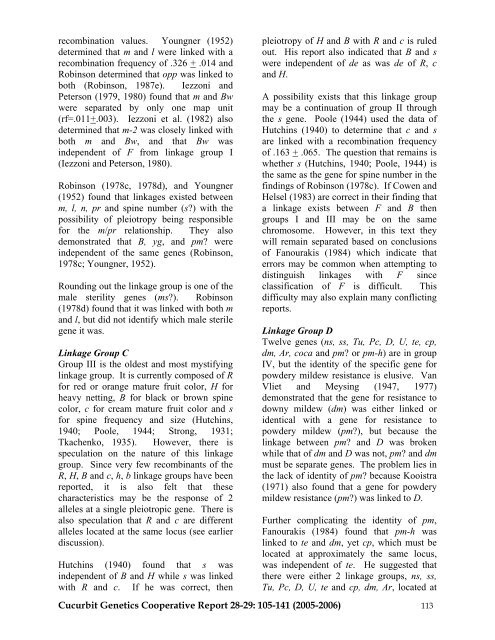Complete volume with articles 1 to 32 - Cucurbit Breeding - North ...
Complete volume with articles 1 to 32 - Cucurbit Breeding - North ...
Complete volume with articles 1 to 32 - Cucurbit Breeding - North ...
You also want an ePaper? Increase the reach of your titles
YUMPU automatically turns print PDFs into web optimized ePapers that Google loves.
ecombination values. Youngner (1952)<br />
determined that m and l were linked <strong>with</strong> a<br />
recombination frequency of .<strong>32</strong>6 + .014 and<br />
Robinson determined that opp was linked <strong>to</strong><br />
both (Robinson, 1987e). Iezzoni and<br />
Peterson (1979, 1980) found that m and Bw<br />
were separated by only one map unit<br />
(rf=.011+.003). Iezzoni et al. (1982) also<br />
determined that m-2 was closely linked <strong>with</strong><br />
both m and Bw, and that Bw was<br />
independent of F from linkage group I<br />
(Iezzoni and Peterson, 1980).<br />
Robinson (1978c, 1978d), and Youngner<br />
(1952) found that linkages existed between<br />
m, l, n, pr and spine number (s?) <strong>with</strong> the<br />
possibility of pleiotropy being responsible<br />
for the m/pr relationship. They also<br />
demonstrated that B, yg, and pm? were<br />
independent of the same genes (Robinson,<br />
1978c; Youngner, 1952).<br />
Rounding out the linkage group is one of the<br />
male sterility genes (ms?). Robinson<br />
(1978d) found that it was linked <strong>with</strong> both m<br />
and l, but did not identify which male sterile<br />
gene it was.<br />
Linkage Group C<br />
Group III is the oldest and most mystifying<br />
linkage group. It is currently composed of R<br />
for red or orange mature fruit color, H for<br />
heavy netting, B for black or brown spine<br />
color, c for cream mature fruit color and s<br />
for spine frequency and size (Hutchins,<br />
1940; Poole, 1944; Strong, 1931;<br />
Tkachenko, 1935). However, there is<br />
speculation on the nature of this linkage<br />
group. Since very few recombinants of the<br />
R, H, B and c, h, b linkage groups have been<br />
reported, it is also felt that these<br />
characteristics may be the response of 2<br />
alleles at a single pleiotropic gene. There is<br />
also speculation that R and c are different<br />
alleles located at the same locus (see earlier<br />
discussion).<br />
Hutchins (1940) found that s was<br />
independent of B and H while s was linked<br />
<strong>with</strong> R and c. If he was correct, then<br />
pleiotropy of H and B <strong>with</strong> R and c is ruled<br />
out. His report also indicated that B and s<br />
were independent of de as was de of R, c<br />
and H.<br />
A possibility exists that this linkage group<br />
may be a continuation of group II through<br />
the s gene. Poole (1944) used the data of<br />
Hutchins (1940) <strong>to</strong> determine that c and s<br />
are linked <strong>with</strong> a recombination frequency<br />
of .163 + .065. The question that remains is<br />
whether s (Hutchins, 1940; Poole, 1944) is<br />
the same as the gene for spine number in the<br />
findings of Robinson (1978c). If Cowen and<br />
Helsel (1983) are correct in their finding that<br />
a linkage exists between F and B then<br />
groups I and III may be on the same<br />
chromosome. However, in this text they<br />
will remain separated based on conclusions<br />
of Fanourakis (1984) which indicate that<br />
errors may be common when attempting <strong>to</strong><br />
distinguish linkages <strong>with</strong> F since<br />
classification of F is difficult. This<br />
difficulty may also explain many conflicting<br />
reports.<br />
Linkage Group D<br />
Twelve genes (ns, ss, Tu, Pc, D, U, te, cp,<br />
dm, Ar, coca and pm? or pm-h) are in group<br />
IV, but the identity of the specific gene for<br />
powdery mildew resistance is elusive. Van<br />
Vliet and Meysing (1947, 1977)<br />
demonstrated that the gene for resistance <strong>to</strong><br />
downy mildew (dm) was either linked or<br />
identical <strong>with</strong> a gene for resistance <strong>to</strong><br />
powdery mildew (pm?), but because the<br />
linkage between pm? and D was broken<br />
while that of dm and D was not, pm? and dm<br />
must be separate genes. The problem lies in<br />
the lack of identity of pm? because Kooistra<br />
(1971) also found that a gene for powdery<br />
mildew resistance (pm?) was linked <strong>to</strong> D.<br />
Further complicating the identity of pm,<br />
Fanourakis (1984) found that pm-h was<br />
linked <strong>to</strong> te and dm, yet cp, which must be<br />
located at approximately the same locus,<br />
was independent of te. He suggested that<br />
there were either 2 linkage groups, ns, ss,<br />
Tu, Pc, D, U, te and cp, dm, Ar, located at<br />
<strong>Cucurbit</strong> Genetics Cooperative Report 28-29: 105-141 (2005-2006) 113
















